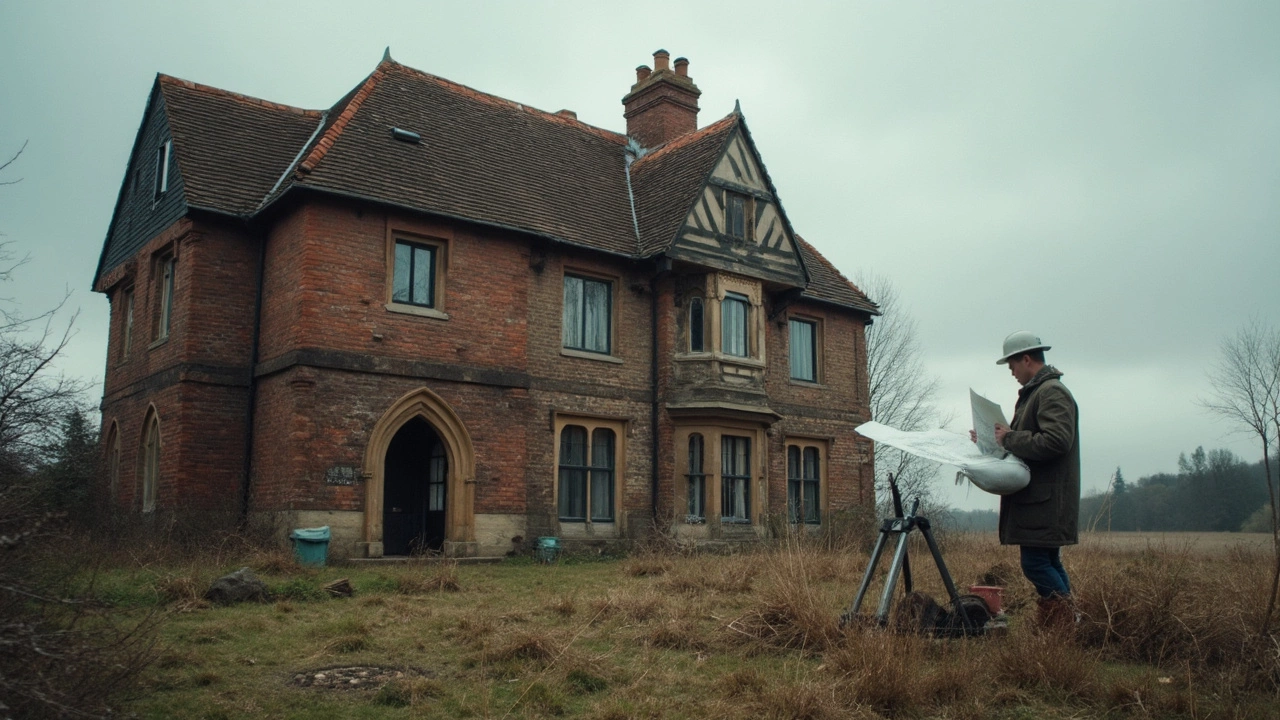So, you're staring at a crack running across your basement floor, and you're in full panic mode, wondering if your house is about to cave in. Foundation problems can feel like a horror story coming to life, right there under your feet. But does fixing it really make a difference, or is this just an expensive gamble?
First things first, understanding why foundations fail in the first place can help demystify the repair process. Common causes include soil issues, excessive moisture, or tree roots sneaking their way into places they don't belong. Whatever the cause, a shaky foundation isn't something to ignore. It's kinda like ignoring a leaky roof—eventually, it's gonna cause more damage.
Now, on to the major question: Does foundation repair actually work? Well, like most things in life, it depends. The effectiveness of a repair largely hinges on the method used and the company's expertise. Whether it's slab jacking, underpinning, or wall reinforcement, each approach has its pros and cons.
- Why Foundations Fail
- Popular Repair Methods
- Assessing Repair Effectiveness
- Signs You Need Repairs
- Tips for Long-Lasting Repairs
Why Foundations Fail
Ever wonder why your home's foundation seems to be throwing in the towel? There are a bunch of reasons why even the best-laid plans can go sideways. Let's dive into a couple of the main culprits.
Soil Problems
One of the biggest reasons for foundation repair is the soil beneath your house. Different soils expand and contract in ways that put stress on your foundation. Take clay soil, for instance. It's like a sponge that swells when wet and shrinks when dry. That movement isn't exactly cozy for concrete.
Water and Moisture Issues
Water, water everywhere? If your home's drainage is less than stellar, this can be a game-changer. Too much water can cause the soil under your house to swell, while too little water can lead it to contract. Both scenarios mess with your home’s structural balance and can ultimately lead to a need for home maintenance.
Poor Construction
While heartbreaking, sometimes it's the construction quality itself. If the folks who built your place didn't focus on the nitty-gritty, like using the right materials or ensuring proper support, you're more likely to have future headaches.
Trees and Roots
Ah, trees. Love 'em outdoors, hate 'em for their roots. Tree roots can extend way farther than you think and draw moisture away from the foundation or even physically shift it. If trees are too close, they might just be your foundation’s worst nightmare.
Check out this quick look at what can influence foundation stability:
| Factor | Effect on Foundation |
|---|---|
| Clay Soil | Expands and contracts, causing instability |
| Poor Drainage | Leads to inconsistent soil moisture levels |
| Inadequate Support | Results in uneven load distribution |
| Tree Roots | Can physically displace foundation or change moisture levels |
Simply put, many elements contribute to foundation issues. Catching them early and understanding the why helps you deal with these problems more effectively and might save you from needing any serious fixes in the future.
Popular Repair Methods
When it comes to foundation repair, a bunch of methods have popped up over the years, each with its own special way of tackling the problem. But regardless of the technique, the main goal stays the same: get your home's foundation back on solid ground. Let's break down some of the go-to repair methods you might encounter.
Slab Jacking
This method's been around the block a few times, and it's a favorite for dealing with sunken concrete slabs. The gist of it? Pumping a grout mixture underneath the slab. Think of it as giving the slab a little lift, kind of like filling a balloon. It's quick, doesn’t break the bank, and usually, you can start using the floor just a day after. However, it's not a magic bullet for every kind of foundation woe.
Underpinning
Underpinning is like beefing up the foundation's roots. It involves extending the foundation depth or breadth for added stability. One popular technique here is the use of helical piers, which resemble giant screws that anchor your home to strong soil layers. If you’re dealing with major settling, especially in older homes, this might be what your contractor suggests. It's on the pricier side, but you often get what you pay for in terms of durability.
Wall Reinforcement
If your basement walls are bowing like a bowed-out rubber chicken, wall reinforcement might be on the menu. Carbon fiber strips and wall anchors are commonly used to straighten and reinforce the walls. It’s a solid option if lateral pressure from the outside soil is the main culprit.
Each of these methods has its pros and cons. Here’s a quick look:
| Method | Pros | Cons |
|---|---|---|
| Slab Jacking | Cost-effective, quick, minimal disruption | Not suitable for all situations |
| Underpinning | Highly durable, long-term solution | Expensive, time-consuming |
| Wall Reinforcement | Prevents further wall bowing | Doesn't fix existing cracks |
The takeaway? Talk with a pro to figure out which repair method makes the most sense for your situation. And remember, patching up a foundation isn't just about fixing what's broken, it's about ensuring you're not patching it up again in a year. Weighing the costs and benefits of each option can save you stress and cash down the road.

Assessing Repair Effectiveness
When it comes to foundation repair, the big question most folks have is: does the fix last? Well, it mainly boils down to a mix of factors, starting with the repair method selected. Some methods are more reliable for specific issues and soil types.
Choosing the Right Method
For example, if you're dealing with a sunken slab, slab jacking is a popular choice. This involves pumping a mixture below the slab to raise it back to its original position. It's generally effective, especially for driveways or sidewalks, but could be a temporary fix if the underlying soil problem isn't addressed.
For homes built on unstable soils, underpinning could be the way to go. The method involves strengthening the foundation by transferring the building's weight deeper. It's more disruptive but often more permanent, especially in areas prone to soil shifts.
Working with the Professionals
A huge part of the equation is the expertise of the repair professionals. Always check their track record, and ask for references. A seasoned foundation repair company usually provides a warranty, sometimes up to 25 years. But remember, the warranty is only as good as the company behind it.
Monitoring the Results
Post-repair, keeping an eye out for new cracks or shifts is crucial. While some minor changes are normal as the house adjusts, persistent or growing cracks need a closer look. An annual check, kind of like a yearly physical for your house, can prevent small problems from turning big.
What Homeowners Say
According to a survey by HomeAdvisor, around 90% of homeowners felt their life quality improved significantly post-repair due to no longer fearing structural issues. Nonetheless, about 15% needed additional work, usually due to unforeseen soil conditions.
In the long run, effective foundation repairs — done right the first time — can save you from future headaches, maintaining your home's structural integrity and, potentially, its resale value. After all, no one wants a sinking house, right?
Signs You Need Repairs
Catching foundation issues early on can save you a ton of headaches—and cash—down the road. So, how do you know when it's time to call in the pros for foundation repair? Let's look at some telltale signs.
1. Cracks Aren't Always Just Cosmetic
Sure, cracks might seem minor, but they're often the first sign of trouble. Look out for horizontal cracks in brickwork or walls, which are usually more concerning than vertical ones. Those bad boys might be telling you your foundation's shifting. Even small gaps can widen over time if left unchecked.
2. Stubborn Doors and Windows
Notice your doors and windows sticking or not closing properly? Unless you've got a drafty old house, this could mean things aren't quite level anymore. It's like when your table wobbles and your coffee's always spilling—annoying and a sign something's up.
3. Uneven Floors
If your floors feel like a funhouse attraction, it's time to investigate. Uneven surfaces could be a result of a sagging foundation. A marble rolling away faster than expected? Yeah, that's not normal.
4. Water, Water Everywhere
Excess moisture or water pooling around your foundation isn't great news. It can erode the soil that your foundation relies on for stability. You gotta address these leaks before they turn a small problem into a big, soggy mess.
5. Unpleasant Odors
If you catch a persistent musty smell in your basement, it might not just be old gym socks. Moisture can lead to mold growth, and mold means your foundation could be compromising your home's air quality and safety.
Quick Reference Table
Here's a quick recap:
| Sign | Description |
|---|---|
| Cracks | Horizontal cracks in walls or brickwork |
| Sticky Doors/Windows | Issues with closing properly |
| Uneven Floors | Noticeable slants or feels off |
| Water Damage | Pooling water or excess moisture |
| Musty Smell | Persistent bad odor indicating mold |
Spot any of these? It might be time to consider calling in a professional to keep your home steady and safe. Foundation repair isn't something to push down the to-do list because, unlike laundry, it's not gonna fold itself!

Tips for Long-Lasting Repairs
Keeping your home's foundation solid isn't just about quick fixes. It's about making those improvements stick. If you want your foundation repair to last, there are a few things you should keep in mind.
Choose the Right Repair Method
Not all foundation issues are created equal, so the first step is to ensure the repair method matches the problem. For instance, if expansive soils are the issue, your focus should be on soil stabilization. Using underpinning might be the best call for sinking foundations, while others might benefit from helical or push piers.
Hire Experienced Professionals
Been tempted to DIY to save some cash? Bad news: foundation repairs aren't a weekend project. An experienced contractor not only brings expertise but also offers warranties, giving you peace of mind that the job's done right.
Regular Maintenance Checks
Preventing future headaches means keeping tabs on your home. Regularly check for new cracks or signs of settling. Look around windows and doors—these are often the first places to show signs of trouble. Think of it like taking your car for a tune-up.
Manage Water Around the Home
Water is both a friend and foe to your foundation. Too much or too little can wreak havoc. Home maintenance 101 includes setting up a proper drainage system. Consider installing French drains if you notice water pooling, and make sure your gutters are clearing water away from the house.
- Inspect gutters and downspouts regularly.
- Ensure soil slopes away from the foundation.
- Consider adding a moisture barrier if your area's prone to heavy rains.
Monitor Landscaping
A beautiful garden is great, but overzealous tree roots are not. Keep large trees a good distance from your foundation, at least their mature height away from the home. This helps prevent roots from sneaking in and causing issues.
By staying on top of these key areas, you're investing not just in a solid foundation but in your home's longevity. A little prevention now can save a lot of hassle—and cash—later on.
